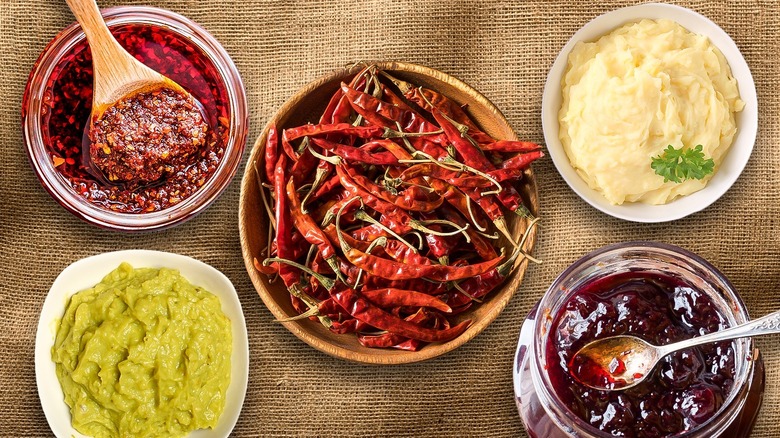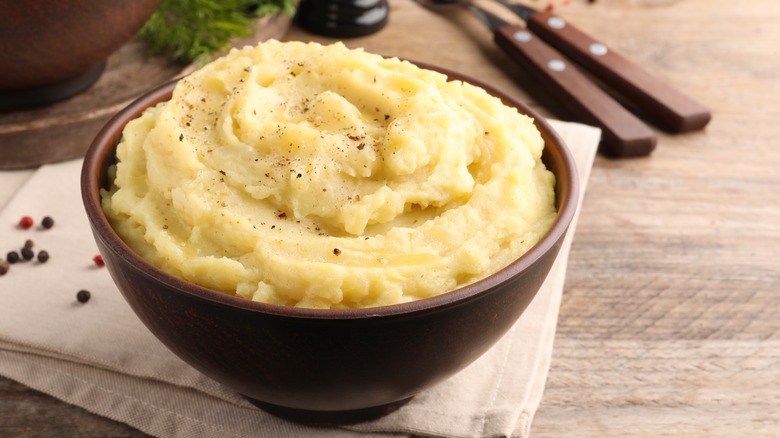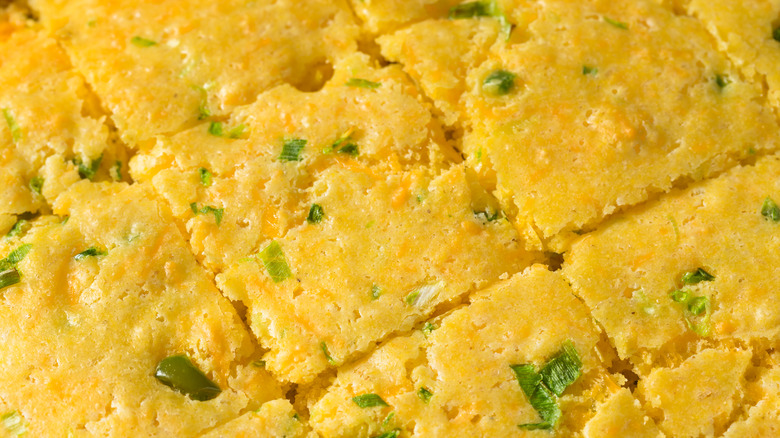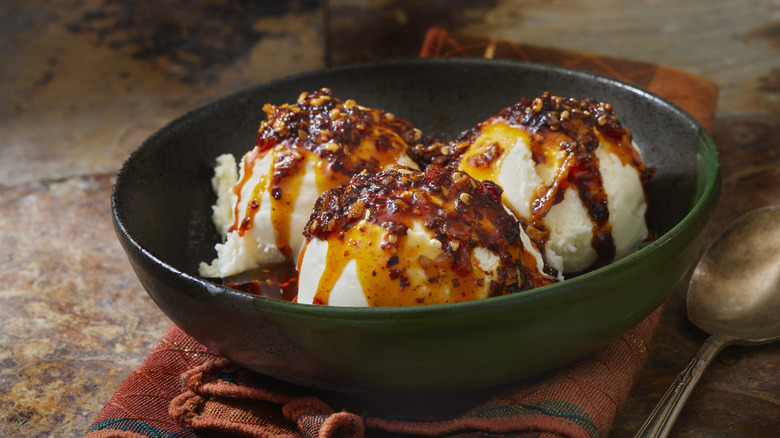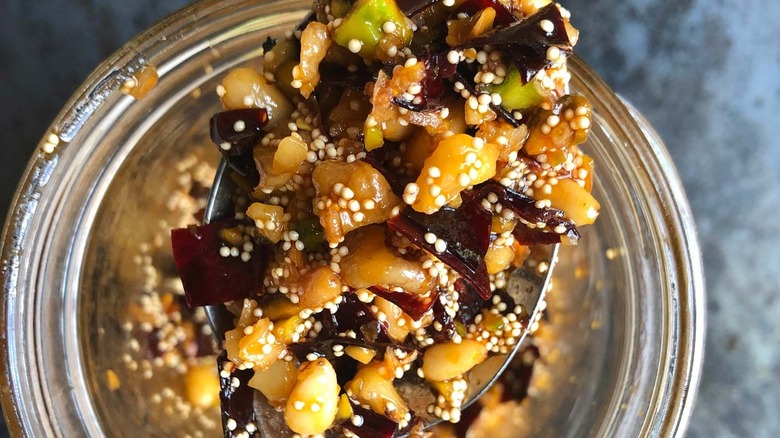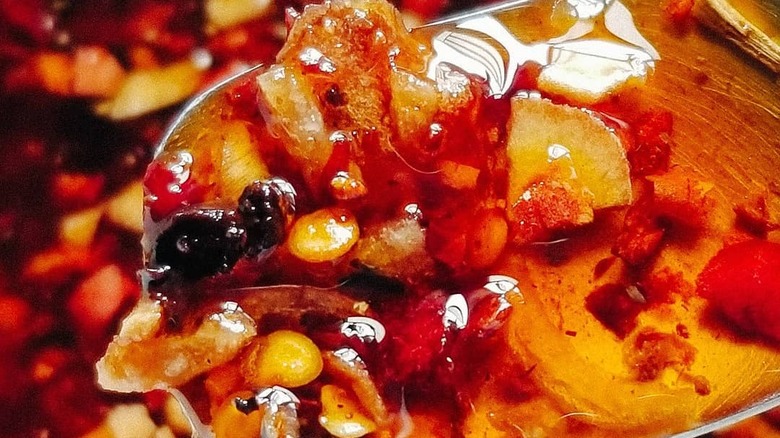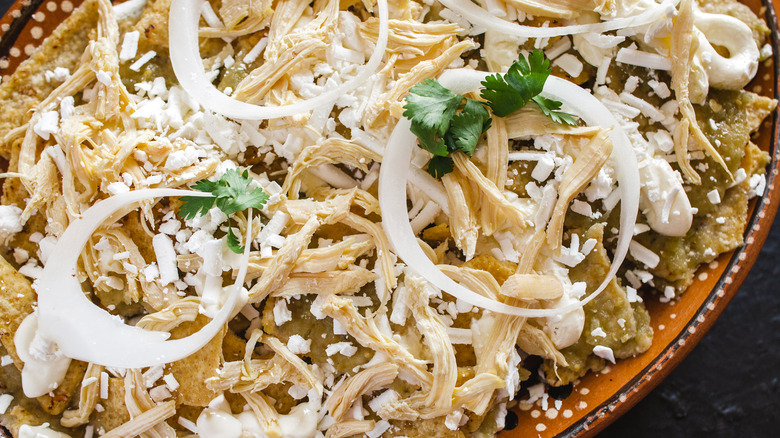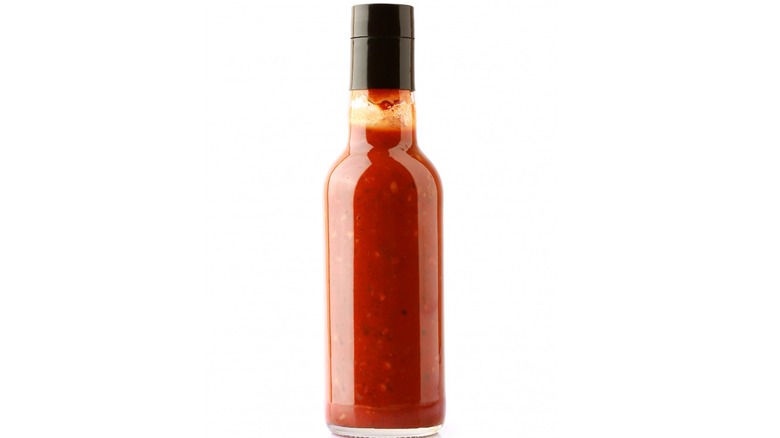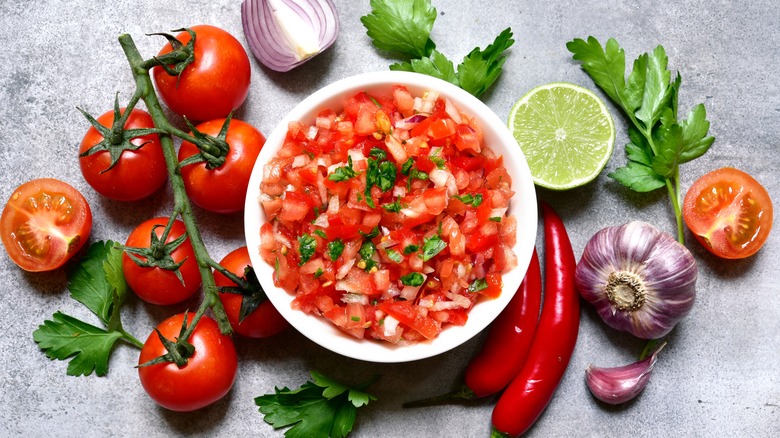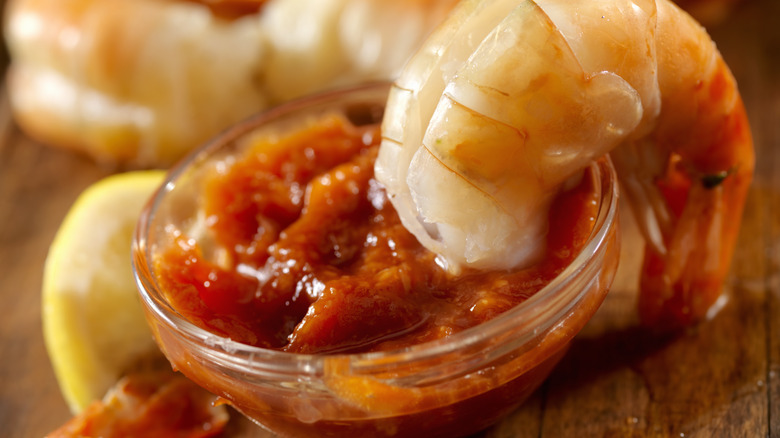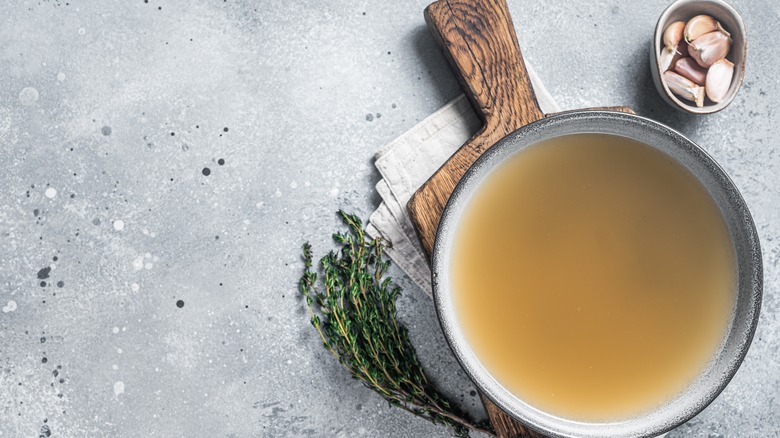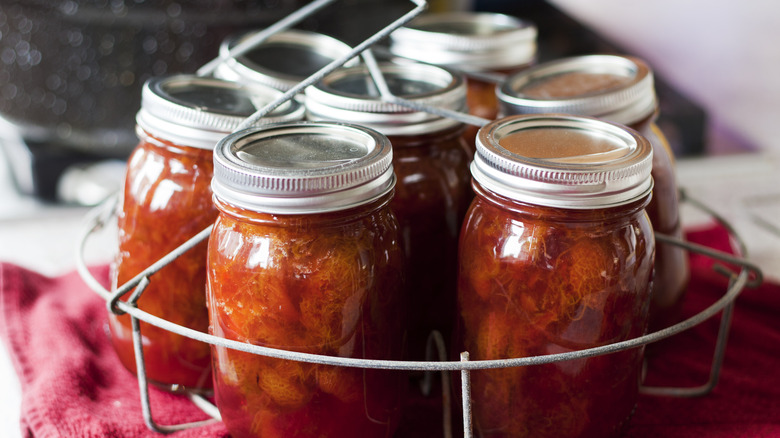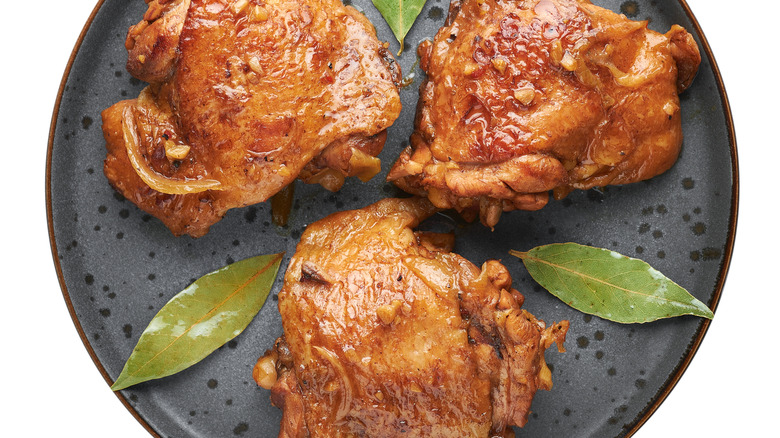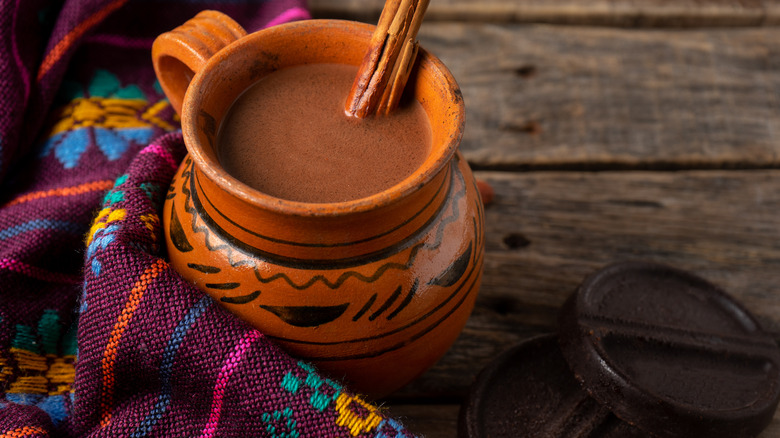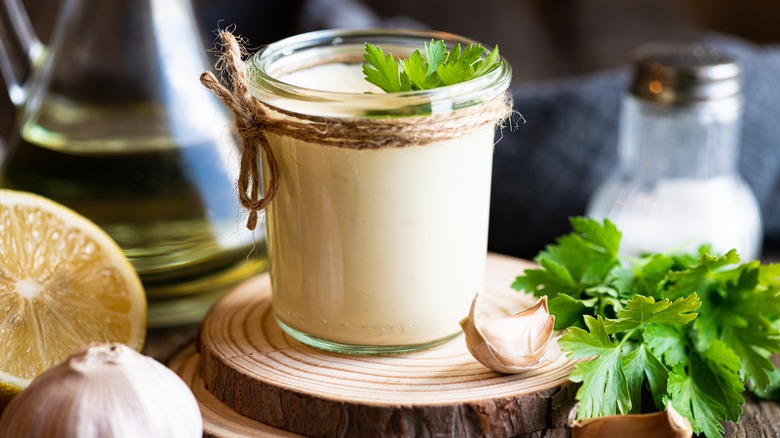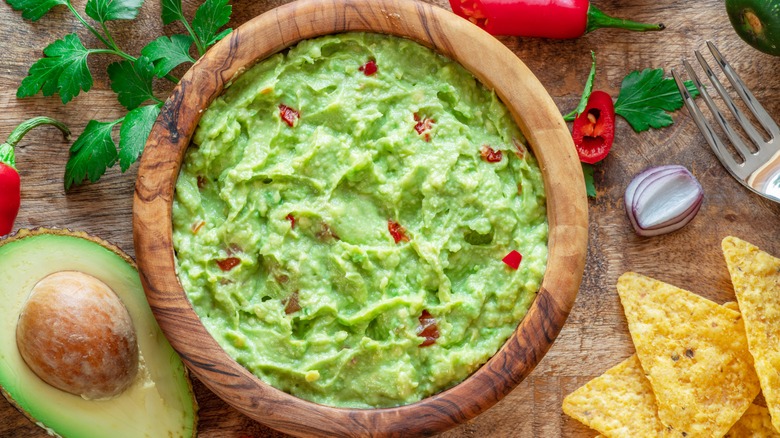15 Creative Uses For Chile De Árbol
A spicy tingle on your tongue is one of the most pleasing sensations. Arriving with a kick that leaves an alluring impression, this fiery feeling often comes from capsaicin – a compound produced in chile peppers. In short, the more capsaicin is present, the hotter a pepper will be. The level of spiciness is measured in Scoville units and tends to vary drastically between peppers. For example, bell peppers have 0 Scoville units while the notorious ghost pepper averages around 1 million Scoville units – with the chile de árbol pepper sitting somewhere in the middle.
One of the most commonly used peppers in the world, the chile de árbol is a popular ingredient for red sauces and spicy seasoning blends. You can taste its piquant punch in popular sauce brands like Cholula, for example, though it contains undertones of smokiness and nuttiness, as well. In that sense, it's a potent pepper that can put a spicy spin on your cooking. If you'd like to incorporate this intriguing chile into more meals, here are some creative ways to turn the heat up with chile de árbol.
Spice up your mashed potatoes
Giving mashed potatoes a fiery injection never gets old. Heat breaks up the monotony of creamy savoriness, after all, which can become boring by itself. As a food with a neutral taste, potatoes pair perfectly with chile de árbol peppers. The root veggies temper the spicier notes — but not too much (so you can still feel the heat).
More than that, chile-infused mashed potatoes are an exceptionally easy dish to make. You can go the fresh route and dice up fresh chile de árbol peppers and blend them into your mix. However, for a more flavorful experience, we recommend boiling dried ones to create a concentrated dose. To do so, first toast the chiles alone in a medium saucepan, then add half-and-half and allow the cream and peppers to simmer over very low heat for 30 minutes.
The chile de árbol peppers blend nicely with the rich consistency of half-and-half. The spicy milkiness will impart flavor when mixed and added to the spuds — leading to some of the most delectable mashed potatoes you'll ever taste.
Give cornbread a peppery kick
Jalapeño-infused cornbread might've come across your dinner table at some point (at least if you're a cornbread lover). If you find that dish's sweet and spicy dance delicious, wait until you experience the peppery punch of chile de árbol cornbread. To be clear: we mean that literally. In fact, while a jalapeño averages between 2,500–8,000 Scoville units, the chile de árbol pepper ranges between 15,000–30,000 Scoville units.
Since these tiny, thinly shaped firebombs contain an undeniable kick, adding them to cornbread makes the heat more palatable without completely neutralizing the chile de árbol's appealing spiciness. For a sweet fix, infusing honey sweet potato cornbread with chile de árbol peppers creates a nice layer of complexity on the tongue.
You can also try amping up the savoriness with chile de árbol and shredded cheese. Perhaps you never thought to turn your cornbread into a lava cake before. But the way the chile-speckled cheese melts from the inside will make you wonder why you waited. Either way, the chile de árbol is sure to spice up your cornbread.
Churn chile-infused ice cream
Another marriage of sweet and savory worth celebrating is chile de árbol-infused ice cream. The idea of spicy ice cream may seem counterintuitive to some. But when that heat is paired with cold, the tension is undeniably tasty — and you may quickly realize that they complement each other as much as they contrast.
Chile-infused ice cream is a simple way to spruce up plain vanilla or chocolate. Spicy chocolate may even be somewhat familiar to you; if so, this saccharine combo should be right up your alley. You can use dried or powdered chile de árbol, as the former can be ground into a powder. Just be sure to remove the seeds from dried chiles if you prefer to reduce the spice level.
When adding ground peppers to store-bought ice cream, you'll want to let it thaw so it's more malleable. For homemade ice cream, simply follow your go-to recipe for vanilla or chocolate and incorporate the pepper powder into the mixture before chilling. Of course, feel free to experiment with any of your favorite ice cream varieties beyond those basic flavors.
Experience satisfaction with salsa macha
One simple way to incorporate chile de árbol peppers into more recipes is by whipping up a batch of salsa macha. Originating in Mexico, salsa macha is a unique variety of salsa that eschews tomatoes. Instead, it's made with chiles de árbol, ancho and guajillo peppers, garlic, peanuts, and oil (plus other ingredients depending on the recipe).
Despite its name, salsa macha is closer to a flavored oil than a standard sauce and tastes similar to chili crisp (though one with a nuttier profile). Salsa macha provides heat, of course — thanks to ingredients like chile de árbol peppers – and the combination of flavors and textures elevates the entire experience.
Furthermore, salsa macha can be used in a variety of ways. Classic Mexican go-tos like tacos, burritos, enchiladas, and quesadillas are a natural pairing, and you can use it to spruce up guacamole. Or step outside of Mexican cuisine and mix salsa macha into a hummus dip, soup, pasta, or any other dish where you think it might work. It even has sweet undertones that complement ice cream.
Make homemade chili crisp
Chili crisp is a go-to flavor topper for foodies everywhere. The spicy, aromatic condiment is typically made with chiles (including dried chile de árbol peppers), Sichuan peppercorns, garlic, and scallions. The smoky, savory, nutty sauce is a staple of Chinese cuisine. But chili crisps can work wonders with any type of food, from scrambles and Mediterranean bowls to pasta and even fiery ice cream.
You only need an hour to make this chile de árbol-featuring condiment, though the flavor of chili crisp intensifies with time. Since it can last up to 3 months in the fridge with proper storage, you'll be able to elevate countless meals with your homemade chili crisp.
However, be forewarned: If you can't take the combined heat of dried chile de árbol and Japones peppers, we recommend staying out of the kitchen. Chili crisp isn't unbearably hot, but it can certainly test your tolerance.
Try a piquant batch of chicken nachos
In the finger food hall of fame, few foods top the deliciousness of nachos. Making them is an art form that requires mindful layering and the even distribution of toppings to avoid biting into a bare tortilla chip. Since nachos can be tricky to perfect, the best part of this comfort classic (besides mounds of cheese) may lie in its versatility. You can go with traditional ingredients like ground beef, beans, and pico de gallo, or opt for a different selection of toppings — including chile de árbol peppers in some capacity.
The pepper's smoky, aromatic flavor is ideal for poultry — and chile de árbol-infused chicken nachos are a dynamite way to break your nacho routine. The recipe is fairly straightforward, though you'll need to make the chile de árbol sauce from scratch. Simmer a mixture of chile de árbol and chicken stock down before blending it into a spicy puree. Once blended, layer it mindfully (and try to cover every tortilla chip).
Recreate Cholula hot sauce at home
The debate over which hot sauce brand is the best rages on. Whether you prefer Tobasco, Louisiana, Red Hot, Crystal, or another variety entirely, a bottle of mouth-burning sauce is a necessary flavor enhancer. One popular brand that sits within the ranks of the hot sauce elite is Cholula. Crafted in Mexico from a 100-year-old recipe, Cholula hot sauce is named after one of Mexico's oldest cities and contains a time-tested flavor profile. Though it's easy enough to stop by the nearest grocery store and buy a bottle, why not flex your sauce skills and recreate Cholula at home with chile de árbol peppers?
Now, we can't say with 100% certainty what the precise recipe is or which ingredients are used by Cholula to make its classic hot sauce. However, some speculate the unspecified "spices" listed among the sauce's ingredients likely consist of paprika, cumin, onion powder, and dehydrated carrot powder (in addition to water, vinegar, garlic powder, and both chile de árbol and piquin peppers). You simply combine all these ingredients — making it yourself allows you control of the quantity, too — and you'll save yourself from making trips to the store for a refill.
Satisfy spice cravings with salsa
Chile de árbol salsa should be next on your to-do list. In literal minutes, you can sharpen your dipping skills (chip or otherwise) in a fresh and spicy bowl of tastiness. There are only a handful of ingredients needed: canola oil, chile de árbol peppers, onion, garlic cloves, canned peeled whole tomatoes, a can of tomato sauce, and 1 teaspoon of salt.
Start by toasting the chiles in a skillet until the color darkens, then add onion and garlic. Next, transfer the cooked ingredients into a food processor or blender, and add the tomatoes, tomato sauce, and salt. Give it a good pureé and serve at room temperature or chilled.
Besides elevating your snacking experience, this salsa has a wide range of craveable applications. Give your morning scramble a dollop of deliciousness, toss it into burrito bowls, make a spicy hummus, or try salsa-ifying meatloaf. If you enjoy seafood, this chile de árbol salsa pairs nicely with ceviche, as well.
Concoct a seafood friendly sauce
The tiny bite of fire that is chile de árbol can be incorporated into all sorts of mouthwatering sauces — and we've got you covered, seafood lovers. After all, with just a few simple ingredients, it's easy to make a chile de árbol-spiced seafood sauce. that's great for shrimp cocktail and crab legs. The ingredients include dried chile de árbol peppers, canola oil, white onion, garlic, tomato paste, cilantro, heavy cream, chicken stock, and honey.
For those into indulgent comfort foods, a drizzle of chile de árbol sauce atop a pile of garlic shrimp mac and cheese is sure to knock your socks off. If you prefer using hands to utensils, a stacked shrimp po boy sandwich with this chile de árbol sauce will never steer you wrong. Spread a healthy layer of chile de árbol sauce on the bun and prepare for seafood satisfaction. With some culinary creativity, you can discover infinite ways to use this tasty spread.
Brew a chile-infused broth
It's never a bad idea to keep a batch of flavor-infusing broth stocked in your kitchen. After all, soups only scratch the surface of how this versatile liquid can be used. Broth serves as a base for jambalaya, hoppin' johns, collard greens, and so much more. So if you're wondering what to do with leftover dried chile de árbol peppers, consider making a homemade broth. Soaking dried chiles in water will extract their spicy potency and create a zesty and savory broth (which is why you should never throw away chili water after removing the peppers).
There are numerous ways to incorporate this peppery brew when cooking. Sprucing up rice is a no-brainer, of course, as is adding it to beans to boost the flavor. You can also use chile de árbol broth when making certain creamy pasta sauces, which will cut the richness by injecting heat.
Make a spicy and sweet plum jam
One "swicy" condiment (see what we did there?) that's bound to spark curiosity is a sweet and spicy plum jam made with chile de árbol and thyme. Infused with chile de árbol peppers, orange peel, and thyme, it's a summer-flavored jam that demands to be spread on everything.
Now, if you've never attempted making homemade jam, don't worry: it's surprisingly easy (and this recipe only takes an hour). Start by gathering pitted plums, sugar, orange peel, fresh lemon juice, thyme, and our spice of the hour — chile de árbol. Unlike sauces, which often require a blender, you only need a large mixing bowl and a 4-quart saucepan to make this jam.
Toss the ingredients into the bowl and allow them to soften for 30 minutes, then transfer them to the saucepan and cook for 15 minutes. You can store the jam in mason jars to be enjoyed with future treats. Plus, since this recipe should yield 8 servings, you'll never be in a jam when desiring it (though your snacks will be).
Swap chipotle for chile de árbol adobo sauce
Adobo sauce is a reddish brown chili paste that has an earthy, smoky, subtly sweet, and peppery taste. With a barbecue-like consistency, it's used as a marinade for meats and seafood, a soup and stew flavor booster, and a saucy condiment for rice dishes. Whereas chipotle is known for smokiness, it's a much milder pepper that doesn't pack the punch that chile de árbol does. For a spicy twist on a traditional Mexican adobo sauce, try swapping chile de árbol for the standard chipotles.
Beyond a general uptick in spiciness, chile de árbol-infused adobe sauce tastes savory and aromatic with tangy notes. It's an especially great alternative to everyday condiments like ketchup, mustard, barbecue sauce, and mayo. Additionally, many adobo sauce recipes incorporate three different pepper varieties, so consider alternating between ingredients like chiles ancho, Morita, pasilla, and guajillo — all of which are commonly used in Mexican cuisine.
Enjoy a creamy cup of Mexican hot chocolate
When the winter chill rolls in, nothing beats a cozy cup of hot chocolate. Drinking it is like being wrapped in a blanket of creamy deliciousness and the taste can make any occasion feel festive. In Mexico, locals often drink hot chocolate with a spicy dose of chile peppers — so why not add chile de árbol to your next cup?
Now, Mexican hot chocolate is distinct from other varieties in ways beyond its spicy kick. For starters, dark chocolate is typically used, as opposed to the milk chocolate common in the U.S. Another difference lies in the inclusion of aromatics like cinnamon and cloves. While some recipes use chili powder or ancho chile, others use the fiery cayenne pepper. Of course, given this article's topic, we'd recommend using chile de árbol.
Incorporating chile de árbol into your hot cocoa is as easy as sprinkling the powder into your mug. It's great when paired with sweets like churros and fruits, and goes well with classic additions like marshmallows and whipped cream, as well.
Elevate sandwiches with chile de árbol aioli
There's skill in choosing the perfect spread for a sandwich. For instance, what condiment compliments a classic turkey club sandwich better than creamy mayonnaise? The same can be said for garlic aioli-topped steak sammies — a mouthwatering combination worth praising the heavens over. Made by emulsifying garlic and olive oil, aioli is the ancient sauce that makes everything taste better. It has a consistency similar to mayo — and a potently rich flavor profile that's ideal for chile de árbol.
In fact, you can easily spruce up aioli with a simple addition of chile de árbol peppers. Adding a kick to this crave-worthy sandwich topper is super simple since you merely blend in powdered chile de árbol and enjoy. You can use it to tune up everyday tuna salad, turn a regular club sandwich into a party favorite, or go plant-based with a veggie-filled, ratatouille-ish eggplant panini. Chile de árbol aioli complements nearly anything.
Whip up chile de árbol guacamole
This list wouldn't be complete without talking about chile de árbol-centric guacamole. After all, jalapeño peppers and red pepper flakes are already popular ingredients, so trying this pepper variety in the Mexican dip is an easy switch. Along with packing more fire, the extra oomph of chile de árbol peppers offers a nice sensation for the tongue. We suggest using dried chile de árbol for this infusion. Before mixing them into your guac, the peppers need to be toasted and ground into a powder.
While the refreshing profile of avocado tempers the spicier notes, you can further balance the heat with a zesty squeeze of fresh lime juice. Chile de árbol guacamole is a spicy curve ball for game day gatherings, summer barbecues, and any occasion that presents an opportunity to wow friends. Besides being dippably delicious, you can use chile de árbol guac to jazz up toast or add it to your favorite sandwich.
